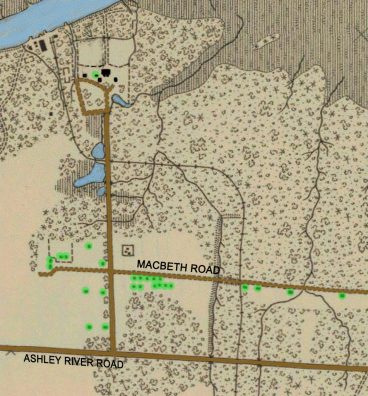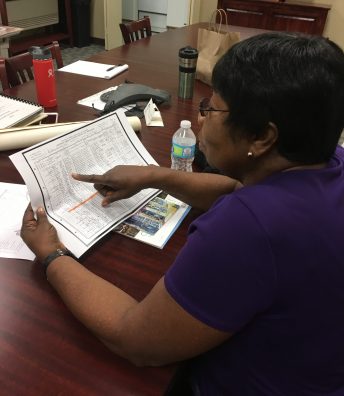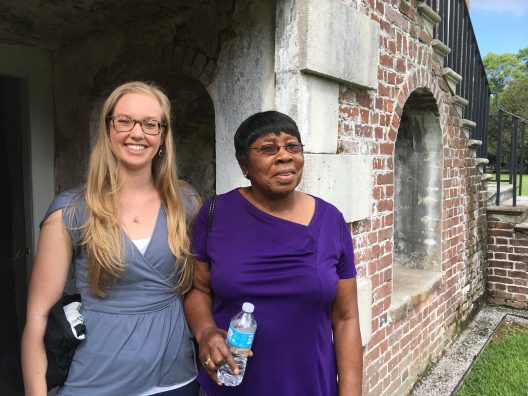Voted the Best Place to See by Condé Nast Traveler.

by Cameron Moon, Assistant Curator of Historic Architectural Resources
With the increasing popularity of genealogy websites like Ancestry.com, more people can track their ancestry back multiple generations without the help of an archivist or a visit to the library. But what do you do if records of your ancestors are scarce or don’t exist? What do you do if your ancestors were considered the property of another person, so they were recorded with no last name? These are the dilemmas that faced Ms. Dorothy Gilliard, a Charleston native who contacted Drayton Hall to learn more about her grandmother, Malsey Doyle (1886–1977), who lived and worked at Drayton Hall during the late nineteenth and early twentieth centuries.
Ms. Gilliard was raised by her grandmother, who shared anecdotes about her life at Drayton Hall, but she and her family still had many questions. In June of last year, Ms. Gilliard’s friend, Terese Shelton, contacted Drayton Hall on her behalf to inquire about any records of Malsey Doyle. Luckily, I was able to verify Malsey Doyle’s residence at Drayton Hall and located her on the 1910 US Census, where she is listed as “Mollie” (a nickname of hers) and noted as living with her parents, five siblings, and two nephews.

1910 US Census Record, St. Andrew’s Parish
The Doyle family was part of the African American community that lived along Ashley River Road and worked in the phosphate mining industry after the Civil War. Mining ended at Drayton Hall by 1910, but people continued to live on the property until the 1960s, working in the gardens and occasionally on the main house. This period was pivotal to the preservation of the site as a whole, and the main house still stands in the condition that it does because of that community and the profits from the mining industry. Just as enslaved people built the walls of Drayton Hall in the eighteenth century, their descendants’ presence on the property through the twentieth century ensured the house’s survival.

This map from 1902 shows the houses that were built at Drayton Hall during the phosphate mining era. Adapted from “Continuation of Ashley River” from the US Coast and Geodetic Survey, 1902
In July, Ms. Gilliard visited Drayton Hall with Terese Shelton and Terese’s brother, Hunt Scarritt. Having never visited a historic plantation before, Ms. Gilliard explained, “Upon learning about the possibility of tracing my family history, I was very excited but taken back a bit for the fear of the unknown.” Upon arrival, we toured the main house and visited the part of the property where the community of phosphate laborers and their families lived beginning in 1866. I showed Ms. Gilliard where her grandmother likely lived, hoping she could envision the landscape dotted with two-room framed houses, gardens, animal pens, and rail lines to transport the mined rock.
After visiting the African American cemetery, we shared our research with one another. Ms. Gilliard brought a photograph of her grandmother and a family history her cousin had prepared, and she spoke extensively about her genealogy. She remembers her grandmother talking about working in the gardens at Drayton Hall. Her grandmother told stories of the women in her family hiding from the overseer on the property, as he was known to exhibit violence towards the women who lived there.

Ms. Gilliard looking at the census record. Courtesy of Terese Shelton
I shared the maps and photographs Drayton Hall has of some women from the community as well as the 1910 US Census record with “Mollie” Doyle’s name on it. Terese Shelton remarked, “It was so moving to share the moment when Cameron tenderly leaned over to show Dorothy the Drayton census report confirming Malsey’s birth. It was one of the most poignant and healing moments you could imagine.”
Having Ms. Gilliard out to Drayton Hall to learn more about her grandmother’s life enriches the interpretation at Drayton Hall just as it enriches Ms. Gilliard’s knowledge of her family. The memories of the individuals who lived on the property help paint a picture of what life was really like, and we don’t have to fill in the gaps as much with our own ideas. We want to hear those stories, whether they are comfortable and relatable or horrific and unimaginable. They are powerful, and they make Drayton Hall more of a living, breathing place, rather than a site frozen in time.
In return, Drayton Hall can provide a link to an untold story. I took Ms. Gilliard to the place where her grandmother grew up, showed her where her house likely stood, and what it looked like. After her visit, Ms. Gilliard reflected, “I began to immediately understand how much of a pivotal role the footprints of my ancestors had contributed to the plantation’s history, just to imagine their work there as slaves and so much they had contributed … I was elated about the knowledge I gained and the experience and the joy in learning.” It’s important that we foster these relationships with the local community, as the history of the site is so intertwined with the people and institutions that remain in the area.
With the construction of the Sally Reahard Visitor Center, we are revamping our interpretation and programming. We are striving to tell a more complete story at Drayton Hall, focusing on the lives of the individuals who lived at Drayton Hall, both free and enslaved, black and white. This story is enhanced by engaging the descendants of these people. Looking forward, we would like to meet more families who believe they can trace their ancestors to Drayton Hall. We’re directing our efforts towards planning a gathering of descendants of anyone who lived and worked at Drayton Hall from the eighteenth through twentieth centuries. Hosting a gathering like this will enhance our understanding of the site, and hopefully we can provide information, answers, and resources to those who seek them. Be on the lookout for information about this event later this year.

Cameron Moon and Ms. Gilliard at the main house. Courtesy of Terese Shelton